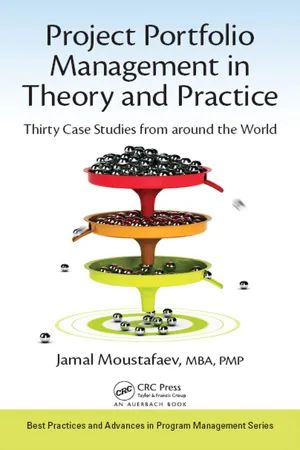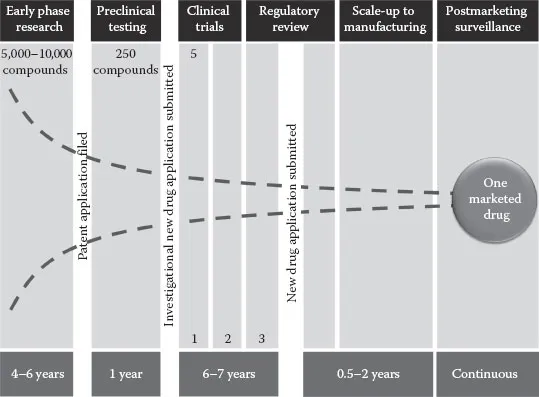
eBook - ePub
Project Portfolio Management in Theory and Practice
Thirty Case Studies from around the World
- 292 pages
- English
- ePUB (mobile friendly)
- Available on iOS & Android
eBook - ePub
Project Portfolio Management in Theory and Practice
Thirty Case Studies from around the World
About this book
Every CEO in the world, if questioned, will always complain that there are a lot of ideas to implement, but, unfortunately, insufficient resources to accomplish them. This book provides a solution to this dilemma by supplying techniques to assess the value of projects, prioritize projects, and decide which projects to implement and which to postpone. In addition, it describes various methods of balancing project portfolios and different strategic alignment models. The book provides thirty real-life project portfolio management case studies from pharmaceutical, product development, financial, energy, telecommunications, not-for-profit and professional services industries.
Frequently asked questions
Yes, you can cancel anytime from the Subscription tab in your account settings on the Perlego website. Your subscription will stay active until the end of your current billing period. Learn how to cancel your subscription.
At the moment all of our mobile-responsive ePub books are available to download via the app. Most of our PDFs are also available to download and we're working on making the final remaining ones downloadable now. Learn more here.
Perlego offers two plans: Essential and Complete
- Essential is ideal for learners and professionals who enjoy exploring a wide range of subjects. Access the Essential Library with 800,000+ trusted titles and best-sellers across business, personal growth, and the humanities. Includes unlimited reading time and Standard Read Aloud voice.
- Complete: Perfect for advanced learners and researchers needing full, unrestricted access. Unlock 1.4M+ books across hundreds of subjects, including academic and specialized titles. The Complete Plan also includes advanced features like Premium Read Aloud and Research Assistant.
We are an online textbook subscription service, where you can get access to an entire online library for less than the price of a single book per month. With over 1 million books across 1000+ topics, we’ve got you covered! Learn more here.
Look out for the read-aloud symbol on your next book to see if you can listen to it. The read-aloud tool reads text aloud for you, highlighting the text as it is being read. You can pause it, speed it up and slow it down. Learn more here.
Yes! You can use the Perlego app on both iOS or Android devices to read anytime, anywhere — even offline. Perfect for commutes or when you’re on the go.
Please note we cannot support devices running on iOS 13 and Android 7 or earlier. Learn more about using the app.
Please note we cannot support devices running on iOS 13 and Android 7 or earlier. Learn more about using the app.
Yes, you can access Project Portfolio Management in Theory and Practice by Jamal Moustafaev in PDF and/or ePUB format, as well as other popular books in Business & Project Management. We have over one million books available in our catalogue for you to explore.
Information
THE APPLICATION: INDUSTRY CASE STUDIES
II
Chapter 4
Project Portfolio Management in the Pharmaceutical Industry
Pharmaceutical Sector Overview
The pharmaceutical sector represents a fairly unique industry among the multitude of businesses that exist in the world. One of the key factors in the world of pharma is that the development time of an average drug can last for 10–15 years, dwarfing the development times for most technology, software, and even engineering products. Furthermore, pharma research and development (R&D) scientists frequently have to assess and analyze between 5,000 and 10,000 compounds before they are able to synthesize one successful drug (see Figure 4.1).
Another aspect of the pharmaceutical industry is its heavy investment in the new drug R&D. For example, in 2011, the pharma industry spent US$135 billion on R&D. When one compares this amount with other industries, the annual spending by the pharma market is five times greater than that of the aerospace and defense industries, 4.5 times more than that of the chemical industry, and 2.5 times more than that of the software and computer services industry (Joint Research Centre, 2011). It is therefore not surprising that 5 out of 10 global R&D companies are pharma. Also, in 2011, 35 new drugs were launched, while another 3200 are still in development.
Another interesting aspect of the pharmaceutical industry is that it continues to be “socially profitable,” so to speak. It is estimated that for every $24 spent on drug development, $89 is saved in healthcare costs worldwide (Ernst and Young, 2012).

Figure 4.1 Pharmaceutical industry life cycle.
In 2011, 35 new pharmaceutical drugs have been launched around the world. The numbers of drugs in various stages of development around the world are
■ Cancer—948
■ Cardiovascular—252
■ Diabetes—212
■ HIV/AIDS—88
■ Rare diseases—460
The experts forecast that the pharmaceutical market will grow to US$1200 billion worldwide in 2016. Along with the growth, an interesting shift will occur with respect to the weight of regional powers that constitute the overall pharma market. For example, the so-called emerging markets that typically include Russia, China, Brazil, India, the Philippines, and South Africa used to consume approximately 12% of the global pharmaceutical output in 2005. However, by 2015, they are expected to represent 28% of the global healthcare spending (more than a twofold increase in share).
On the other hand, the share of the United States is expected to fall from 41% of the global market in 2005 to 31% in 2015. By the same token, the European share of the global pharmaceutical consumption will drop from 27% in 2005 to 19% in 2015.
Moreover, many health authorities around the world are now requiring pharmaceutical companies to track and report patients’ experiences (referred to as “pharmacovigilance”). These reporting requirements are becoming stricter, raising the investment cost of a given medicine as long as it is being marketed. As a result of this new regulatory requirement, there is an upward pressure applied on R&D costs and a downward pressure on the number of drugs in development:
■ 196 drugs developed in 1997–2001
■ 146 drugs developed in 2007–2011
One must also consider factors such as the aging world population (especially in developed countries), increased life expectancy, and unhealthy lifestyles that have contributed to the relative growth of noncommunicable diseases such as heart disease, cancer, chronic respiratory diseases, and diabetes.
So, what are the conclusions and lessons learned from these facts and figures? First, the composition of the world pharmaceutical market is shifting from the developed countries (e.g., United States, Canada, and western European countries) toward the developing countries with a large and relatively wealthy population (e.g., Russia, China, India, and Brazil). This implies at least two things: developing new drugs that fit the characteristics of the new markets and establishing closer relationships with local regulatory bodies.
Stringent regulation in the old and new markets, increased competition and the resulting downward pressure on the revenues, and the numbers of new drugs approved per year will force the pharmaceutical industry to become more agile and innovative.
The price for such innovativeness will probably manifest itself in terms of increased risk for new product development projects. As a result, managing these risks properly will present the pharmaceutical companies with significant challenges. Furthermore, some experts argue that pharma companies with well-balanced project portfolios will outperform those that attempt to build their portfolios under the slogan “we will take only winner products” (Ernst and Young, 2012).
Finally, faced with decreasing or stagnant revenues, pharma companies will also try to reduce their development costs probably by focusing on their core competencies rather than venturing into completely new fields.
Pharmaceutical Sector Case Studies
Introduction
In this section, we will examine several different pharmaceutical companies: the first one is a large and financially successful organization, the second one is also a large company that experienced a somewhat stagnant growth in its financials, and the third one is a smaller firm...
Table of contents
- Cover
- Half Title
- Title Page
- Copyright Page
- Dedication
- Table of Contents
- Preface: Why Another Book on Project Portfolio Management?
- About the Author
- SECTION I THE THEORY
- SECTION II THE APPLICATION: INDUSTRY CASE STUDIES
- SECTION III SUMMARIZING IT ALL
- References
- Bibliography
- Index